As a professional photographer, I understand the importance of choosing the right lens for portrait photography. The lens you use can significantly impact the quality and style of your portraits.
In this guide, I will walk you through the different types of lenses available for portrait photography, discuss factors to consider when selecting a lens, and provide recommendations for the best lenses in various price ranges.
Whether you’re a beginner or a seasoned photographer, this guide will help you make an informed decision when choosing the perfect lens for your portrait photography journey.
Understanding the Importance of Choosing the Right Lens for Portrait Photography
When capturing stunning portraits, the lens you use plays a crucial role. A good lens can help you achieve sharpness, clarity, and beautiful bokeh in your images. It can also allow you to control the depth of field and create a pleasing background blur to make your subject stand out. On the other hand, using the wrong lens can result in distorted proportions, unflattering angles, and overall lackluster images.
Different Types of Lenses for Portrait Photography
Various types of lenses are available for portrait photography, each with its own strengths and characteristics. The two main categories are prime lenses and zoom lenses.
Prime Lenses
Prime lenses have a fixed focal length, meaning they don’t zoom in or out. They are known for superior image quality, broad aperture capabilities, and sharpness. Prime lenses are trendy among portrait photographers because they allow you to achieve a shallow depth of field, resulting in a creamy background blur that beautifully isolates your subject. Some popular prime lenses for portrait photography include the 50mm f/1.8, 85mm f/1.4, and 135mm f/2.
Zoom Lenses
On the other hand, Zoom lenses offer the flexibility of adjusting the focal length. They allow you to zoom in and out, making them versatile for various shooting situations. While zoom lenses may not offer the wide apertures of prime lenses, they make up for it with their convenience and versatility.
Zoom lenses are an excellent choice for portrait photographers who want the flexibility to frame their subjects differently without physically moving. Some popular zoom lenses for portrait photography include the 24-70mm f/2.8 and 70-200mm f/2.8.
Factors to Consider When Selecting a Lens for Portrait Photography
When selecting a lens for portrait photography, several factors should be considered to ensure the right choice. These factors include the focal length, aperture, image stabilization, and build quality.
Focal Length
The lens’s focal length determines how much of the scene you can capture and how much magnification it provides. For portrait photography, focal lengths between 50 and 135mm are commonly used. A focal length of around 85mm is ideal for capturing headshots and close-up portraits, as it offers a flattering perspective and minimal distortion.
Aperture
The aperture of a lens determines how much light it can gather and how shallow the depth of field can be. A wider aperture (smaller f-number) allows for more light and a shallower depth of field, which can help create a pleasing background blur. In portrait photography, lenses with wide maximum apertures, such as f/1.4 or f/1.8, are highly recommended for achieving professional-looking results.
Image Stabilization
Image stabilization is a feature that helps reduce camera shake, resulting in sharper images, especially in low-light conditions or when shooting at slower shutter speeds. While not necessary for portrait photography, image stabilization can be beneficial if you often shoot handheld or in challenging lighting conditions.
Build Quality
The build quality of a lens is an important consideration, especially if you plan on using it frequently or in demanding environments. Look for lenses with durable construction, weather sealing, and smooth focusing and zooming mechanisms. Investing in a lens with good build quality ensures longevity and reliability.

Best Lenses for Portrait Photography in Different Price Ranges
Now that we have discussed the different types of lenses and factors to consider let’s dive into some recommendations for the best lenses for portrait photography at various price ranges.
Budget-Friendly Options
If you’re on a tight budget, great lens options can still deliver impressive results. The nifty fifty, or the 50mm f/1.8 lens, is popular among photographers due to its affordability and excellent image quality. It offers a wide aperture, making it ideal for creating a shallow depth of field and beautiful bokeh. Another budget-friendly option is the 85mm f/1.8 lens, which provides a flattering perspective and produces sharp, high-quality images.
Mid-Range Options
If you want to spend more, several mid-range lenses offer exceptional performance and build quality. The 24-70mm f/2.8 lens is a versatile zoom lens that covers a wide range of focal lengths, making it suitable for various types of portrait photography.
It offers a fast aperture of f/2.8 throughout the zoom range, allowing for excellent low-light performance and creative depth of field control. Another popular mid-range option is the 70-200mm f/2.8 lens, which provides excellent zoom capabilities and beautiful background blur.
High-End Options
For those who are looking for the best of the best, high-end lenses offer unmatched performance and image quality. The 85mm f/1.4 lens is a favorite among professional portrait photographers for its exceptional sharpness, stunning bokeh, and flattering perspective. It is often called the “portrait lens” because it captures subjects with incredible detail and clarity.
Another high-end option is the 135mm f/2 lens, which offers a longer focal length and superb image quality. It is perfect for capturing headshots and full-body portraits with stunning precision.
Lens Recommendations for Different Types of Portrait Photography
Portrait photography encompasses various styles and subjects, from studio to environmental portraits. Here are some lens recommendations for different types of portrait photography:
Studio Portraits
Prime lenses with wide apertures are often preferred for studio portraits, where you have control over the lighting and environment. The 85mm f/1.4 or the 135mm f/2 lens are excellent choices for capturing stunning studio portraits with great detail and beautiful background separation.
Environmental Portraits
Environmental portraits aim to capture the subject in their natural surroundings, whether in their home, workplace, or a scenic location. Zoom lenses with a versatile focal range, such as the 24-70mm f/2.8 or the 70-200mm f/2.8, are ideal for this type of photography as they allow you to frame the subject within their environment and capture a variety of perspectives.
Lifestyle Portraits
Lifestyle portraits capture candid and natural moments of the subject’s everyday life. For this style of photography, a lightweight and versatile lens like the 50mm f/1.8 or the 35mm f/1.8 can be a great choice. These prime lenses offer wide apertures and a standard focal length, allowing you to capture authentic and intimate moments easily.

Lens Accessories to Enhance Your Portrait Photography
In addition to choosing the right lens, several accessories can enhance your portrait photography experience. Here are a few worth considering:
Lens Filters
Lens filters, such as UV filters and polarizers, can help protect your lens from scratches and dust while improving image quality. UV filters reduce haze and improve contrast, while polarizers enhance color saturation and reduce reflections. These filters are handy when shooting outdoors or in challenging lighting conditions.
Lens Hoods
A lens hood is a handy accessory that helps prevent lens flare and ghosting caused by stray light entering the lens. It also provides additional protection to the front element of the lens. Using a lens hood can significantly improve your portraits’ contrast and overall image quality, especially when shooting in bright sunlight or with artificial solid lighting.
Tripod
While not directly related to the lens, a tripod is an essential accessory for portrait photography, especially when shooting in low-light conditions or when you must keep the camera steady for longer exposures. A sturdy tripod can help eliminate camera shake and ensure sharp images, allowing you to focus on directing your subject and capturing the perfect moment.
Tips for Using Your Chosen Lens Effectively in Portrait Photography
Once you have chosen the perfect lens for your portrait photography, here are some tips to help you make the most out of it:
Familiarize Yourself with the Lens
Take the time to get to know your lens inside out. Experiment with different apertures, focal lengths, and shooting techniques to understand their capabilities and limitations. This will help you make informed decisions while shooting and allow you to maximize the potential of your chosen lens.
Use Shallow Depth of Field to Your Advantage
One of the advantages of using prime lenses with wide apertures is the ability to create a shallow depth of field. Experiment with different aperture settings to achieve the desired level of background blur and make your subject stand out. Consider the distance between your subject and the background to create a pleasing separation and emphasize your subject’s features.
Pay Attention to Composition
Composition plays a crucial role in portrait photography. Pay attention to the placement of your subject within the frame, the background elements, and the overall balance of the image. Use leading lines, framing, and the rule of thirds to create visually pleasing and engaging portraits.
Lens Maintenance and Care for Optimal Performance
To ensure your lens’s optimal performance and longevity, it’s essential to take proper care of it. Here are some tips for lens maintenance:
Keep Your Lens Clean
Regularly clean your lens to remove any dust, smudges, or fingerprints that may affect image quality. Use a lens cleaning solution and a microfiber cloth to wipe the lens surface gently. Avoid using harsh chemicals or abrasive materials that can scratch the lens.
Store Your Lens Properly
Store your lens in a clean and dry environment when not in use. Use lens caps to protect the front and rear elements from dust and scratches. Consider investing in a lens pouch or case for added protection, especially when traveling.
Handle Your Lens with Care
Be mindful of how you handle your lens to avoid accidental drops or damage. Hold the lens by the barrel, not the front element, and avoid touching the glass surfaces with your fingers. Lens hoods provide additional protection against bumps and impacts.
Conclusion: Choosing the Perfect Lens for Your Portrait Photography Journey
Choosing the right lens for portrait photography is a crucial decision that can significantly impact the quality and style of your images. You can make an informed decision by understanding the different types of lenses, considering the factors that matter most to you, and exploring various lens options. Whether you opt for a prime lens or a zoom lens, prioritize image quality, aperture capabilities, and build quality to ensure your chosen lens meets your needs.
Remember to consider the type of portrait photography you wish to pursue and select accessories for your shooting experience. With the right lens, practice, and creativity, you’ll be well on your way to capturing stunning and captivating portraits.

